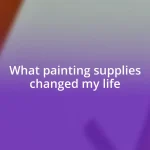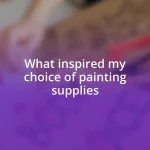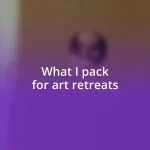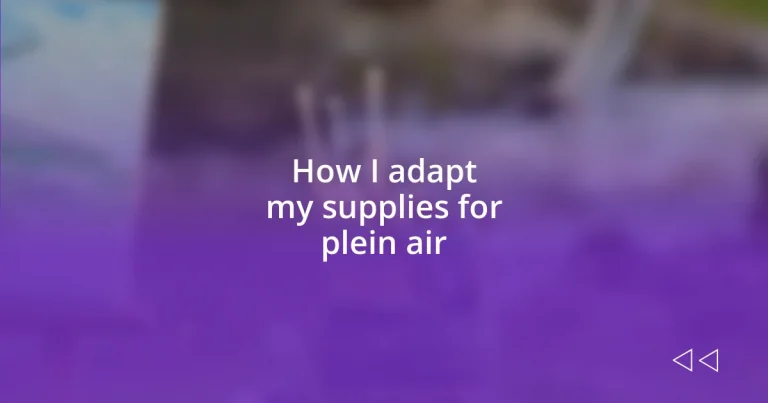Key takeaways:
- Choosing lightweight, portable supplies enhances the plein air painting experience, allowing artists to focus on creativity rather than gear logistics.
- Selecting the right medium (oil, acrylic, or watercolor) depends on the artist’s style and the environment, with each offering unique advantages and challenges.
- Comfort and organization are crucial; investing in practical accessories and preparing supplies based on location can significantly improve the painting experience outdoors.
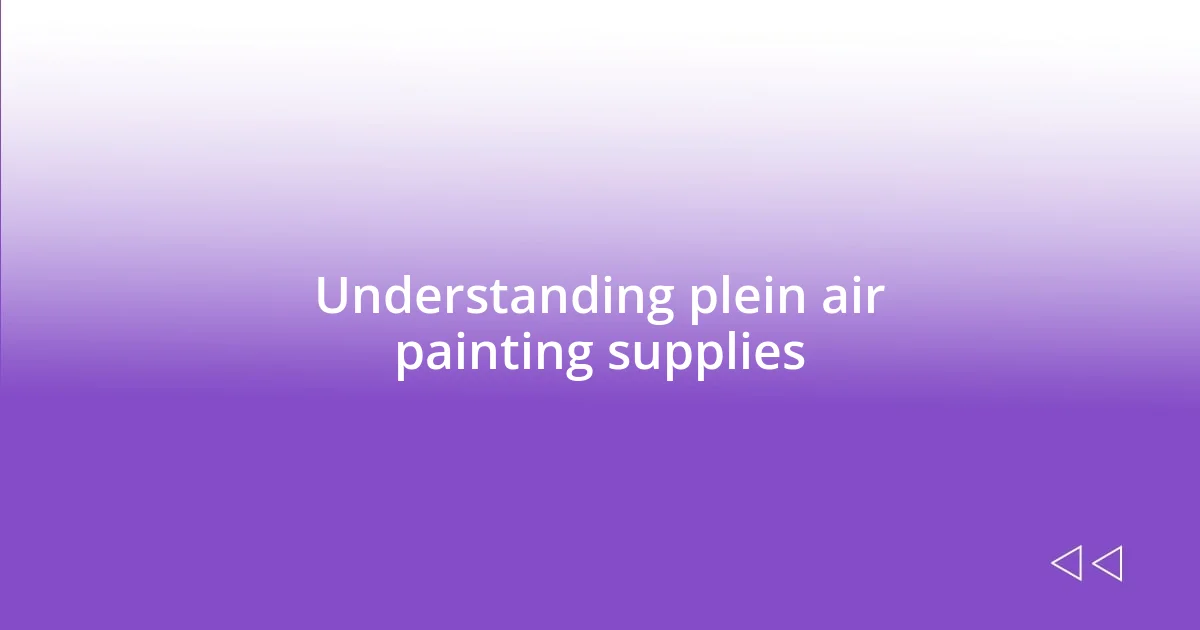
Understanding plein air painting supplies
When it comes to plein air painting supplies, I often think about how every item serves a unique purpose. A sturdy easel is essential, of course, but have you ever considered the importance of portability? I remember the first time I took my lightweight plein air setup to a bustling park. The ease of carrying everything allowed me to focus more on capturing the moment rather than worrying about my gear.
And then there’s paint selection—how do you choose the right colors for the scene in front of you? I usually opt for a limited palette to encourage creativity and challenge myself. One memorable afternoon, I found myself at the edge of a tranquil lake, blending unexpected hues to match the shifting light. It felt like a joyful puzzle, emphasizing how the right supplies can enhance your artistic experience.
Lastly, don’t underestimate the role of practical accessories. A good sun hat or a portable stool can make hours spent outdoors much more enjoyable. I vividly recall crouching for hours on my first plein air outing, and the regret of not having a more comfortable setup. What little comforts can you bring to ensure your focus stays on the canvas?
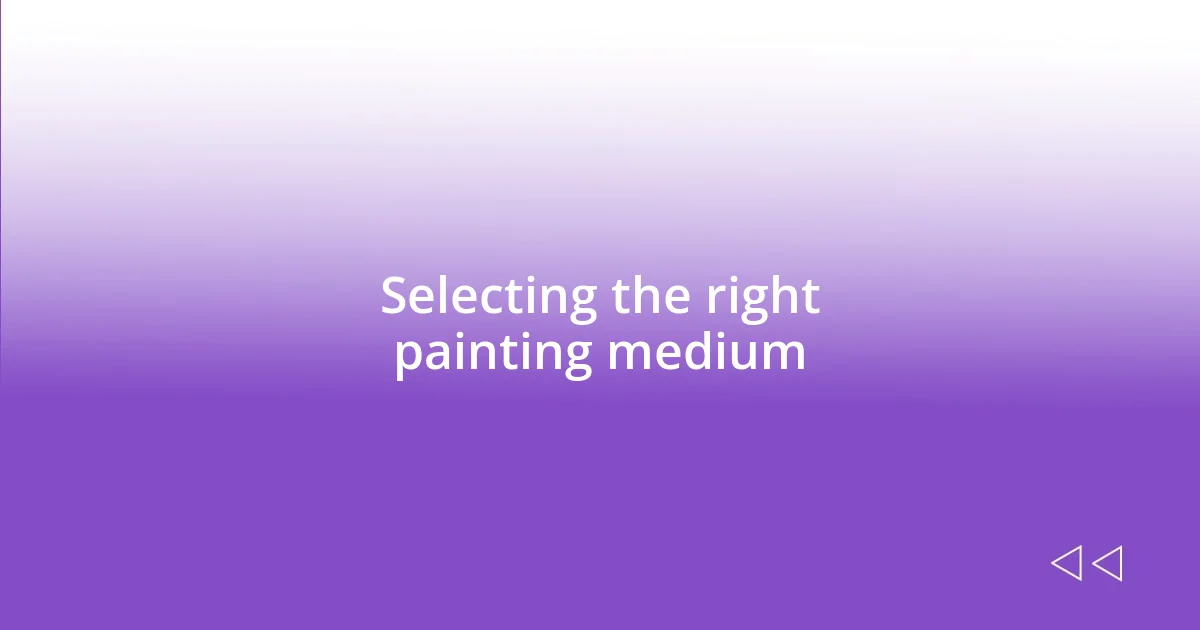
Selecting the right painting medium
Choosing the right painting medium for plein air is crucial to capturing the essence of a scene. I’ve experienced how oil paints can beautifully capture colors, but they require more drying time. In contrast, acrylics offer quick-drying versatility, which I found particularly useful during a windy day at the beach. The last thing you want when you’re out in nature is paint blowing off your palette!
Watercolor is another fascinating option. I remember a day when I switched to watercolors while painting a bustling farmer’s market. The fluidity of the medium allowed me to create soft washes that mirrored the liveliness around me. However, I’ve also learned that watercolors can be unpredictable outdoors, which can be both thrilling and challenging. Isn’t it exciting yet nerve-wracking to embrace that unpredictability?
Ultimately, the choice of medium should align with your style and comfort level. If you thrive in spontaneous, quick strokes, acrylics may be your best friend, while those who enjoy layering and blending might lean toward oils. Reflecting on your experiences with different mediums enhances your plein air practice, and I often find that switching things up leads to unexpected breakthroughs.
| Medium | Advantages |
|---|---|
| Oil | Rich colors, great depth, longer drying time |
| Acrylic | Quick-drying, lightweight, versatile |
| Watercolor | Portability, soft washes, blending capabilities |
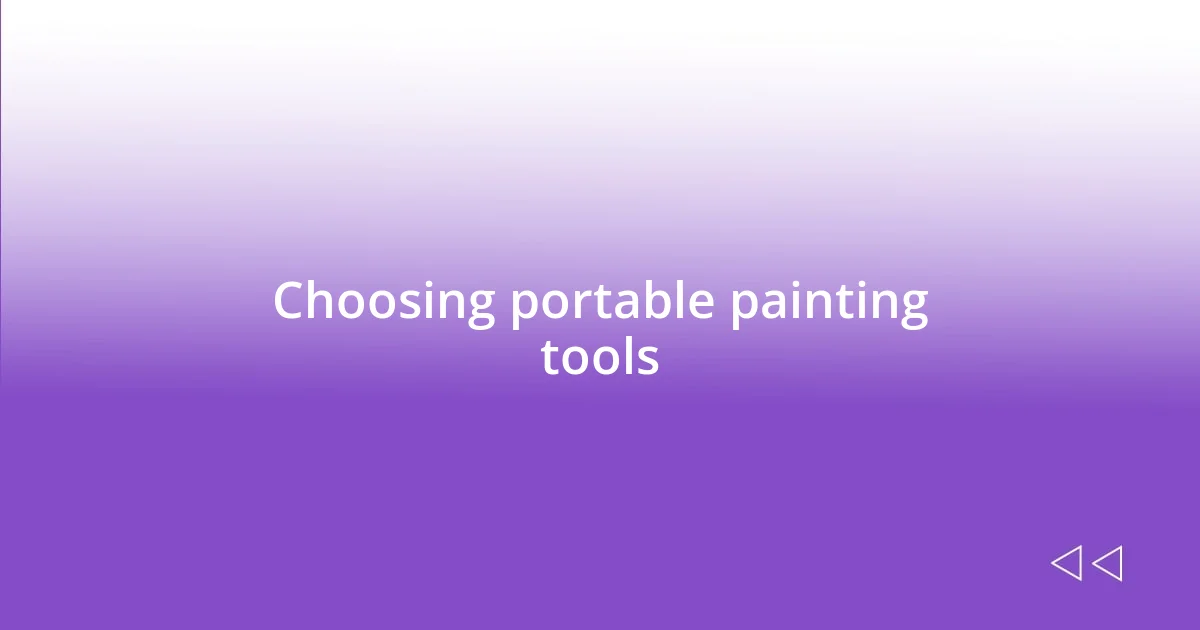
Choosing portable painting tools
Choosing the right portable painting tools can significantly impact your plein air experience. I still remember the first time I packed up my travel easel and brushes for a weekend at the mountains. The excitement of setting up my gear in the fresh air was undeniable, but I quickly realized how essential my choices were. A lightweight setup made all the difference, allowing me to easily reposition and find the perfect angle without straining my back.
As I honed my approach, certain tools became staples in my kit. Here’s a list of considerations that I find essential when selecting portable painting tools:
- Compact Easel: A sturdy yet lightweight easel is key; it should fold easily and withstand outdoor conditions.
- Travel Palette: Opt for a palette that’s easy to clean and transport. I love my collapsible one—it saves space and hassle!
- Brush Selection: Choose durable brushes in varied sizes. I’ve learned that synthetic options work well outdoors; they hold up against wind and wear.
- Water Container: A secure, leak-proof container for water is vital. I often use an old, repurposed bottle, which simplifies my packing.
- Plein Air Bag: Having a designated bag to store everything can keep your supplies organized. I made a point to invest in one with multiple compartments to easily access what I need.
By carefully selecting your tools, you can enhance both your comfort and flexibility while painting outdoors, transforming each session into a joyful exploration of creativity.
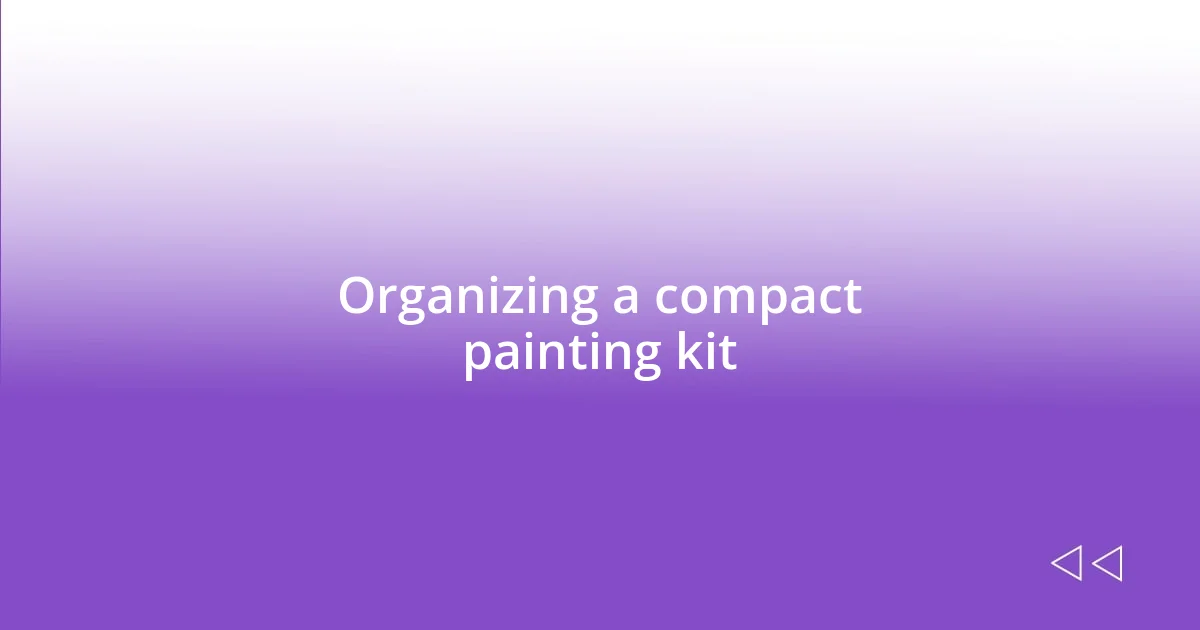
Organizing a compact painting kit
Organizing a compact painting kit is all about efficiency and accessibility. I remember one sunny afternoon where I tried to juggle multiple palettes, brushes, and tubes. It wasn’t long before I found myself fumbling, creating a small mess that almost overshadowed my creative flow. Now, I prioritize a minimalist approach, carefully selecting only essential items that can fit in a lightweight backpack.
One tip I find immensely helpful is using a multi-functional palette. I once discovered a palette that not only held my paints but also had compartments for brushes and a space for mixing. This transformation made it so easy to reach for what I needed when inspiration struck. Have you ever wished your supplies were just a little more streamlined? Trust me, a well-organized kit can eliminate that frustrating moment of digging through clutter while the perfect scene awaits your gaze.
Lastly, I make it a habit to prepare my kit based on the location and conditions. When I ventured to paint at the beach, I included sunblock and a hat alongside my paints. This simple adjustment allowed me to focus on capturing the beautiful waves without being sidetracked by discomfort. The right organization not only streamlines your creative process but also enhances your overall painting experience, leaving room for spontaneity and joy.
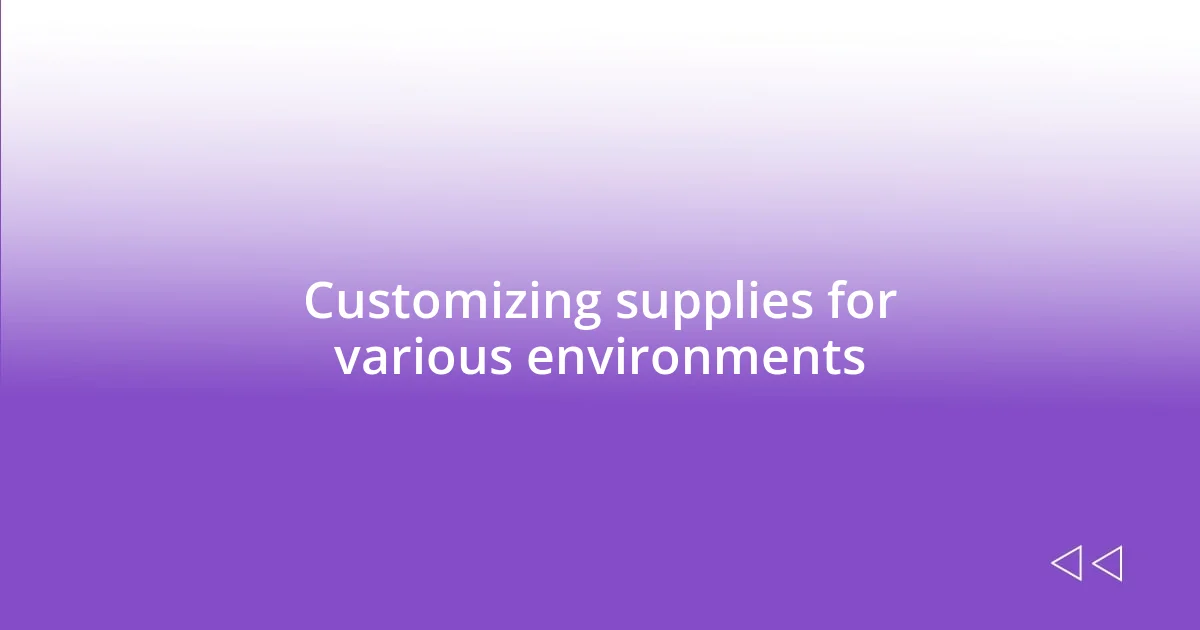
Customizing supplies for various environments
Adapting my supplies for different environments has become second nature to me over the years. For instance, when I’m painting in a lush forest, I take special care to bring water-resistant materials—those unexpected rain showers can sneak up on you! I even recall a day when I was completely caught off guard by a downpour. My sketchbook was spared, thanks to my smart choices. Have you ever had your art supplies compromised by the elements? Believe me, it’s not a fun experience.
In more urban settings, I find myself adjusting not only my supplies but also my mindset. The energy of the city can be overwhelming, and my usual gear might feel too bulky in cramped spaces. I’ve learned to modify my kit to include a smaller, adjustable easel that adapts well to different scenes, from bustling streets to serene parks. I cherish those moments when I can capture the morning light reflecting off glass buildings. Isn’t it fascinating how our surroundings can shape our artistic choices?
When heading to the coast, I focus on creating a supply list tailored to both the scenery and the weather. On a recent trip, I made a point of bringing sand-proof brushes and a sealed palette. I couldn’t help but feel a sense of relief as the waves danced and I got lost in painting them, free from the worry that sand would ruin my tools. Have you considered how little tweaks to your kit can elevate your experience? I truly believe that customizing your supplies based on your environment not only safeguards your creativity but also enhances your connection to the place you’re painting.
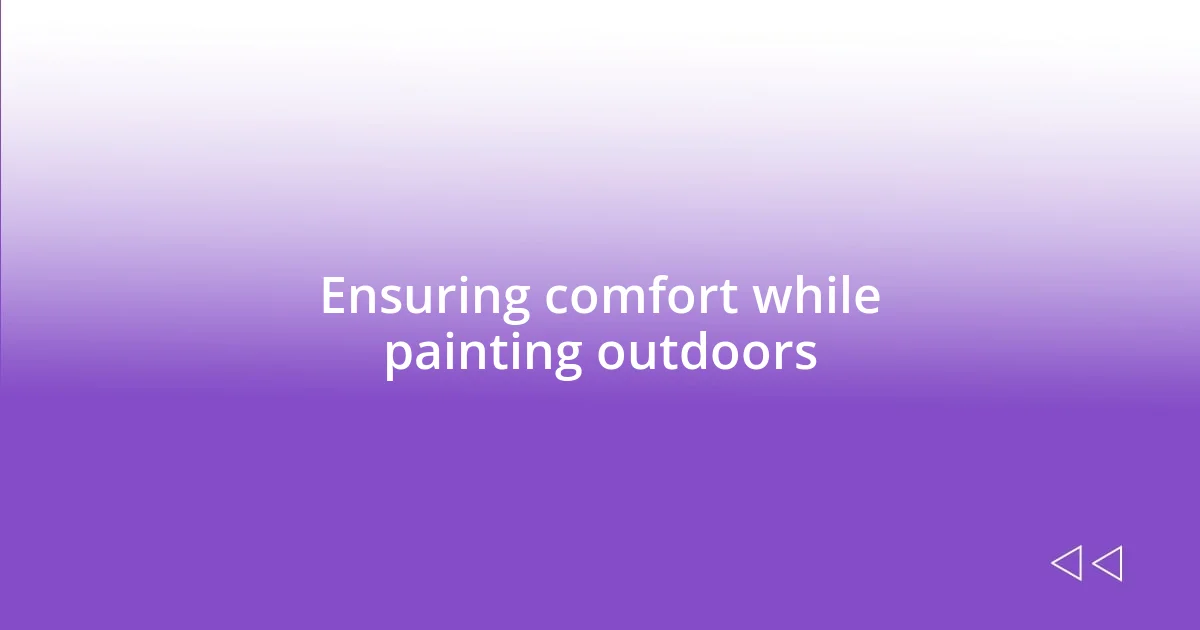
Ensuring comfort while painting outdoors
Finding comfort while painting outdoors is not just about the supplies you bring, but also about the environment you create for yourself. I vividly remember a day when I chose a picturesque spot by a lake. The sun was warm, but I was seated directly on a rocky surface. By the end of the day, my back was sore, and I realized that investing in a portable chair could’ve made a world of difference. Have you ever tried to focus on your painting while discomfort nagged at your body? A simple chair can enhance your experience tenfold, allowing you to fully immerse yourself in your art.
Moreover, I can’t stress enough the importance of dressing appropriately for the weather. There was a time I wore a beautiful summer dress to paint, thinking it was the perfect choice for a sunny day. However, as the temperature dropped unexpectedly, I spent the afternoon shivering and disconnected from my creative flow. Now, I always check the forecast and layer my clothing accordingly. What’s the point of capturing a breathtaking scene if you’re distracted by the cold? Comfort in clothing can significantly affect your ability to focus on your canvas.
Finally, having the right gear can transform a painting session into a delightful experience. On a rainy day, I remember setting up underneath a resilient tree, holding an umbrella with one hand while I tried to paint with the other. It wasn’t ideal! I learned the hard way about the importance of a sturdy, adjustable canopy to shield me from light drizzle or harsh sunlight. Have you thought about how setting up a comfortable work area can elevate your outdoor painting game? Trust me, when you eliminate those little barriers to comfort, creativity flows much more freely.



